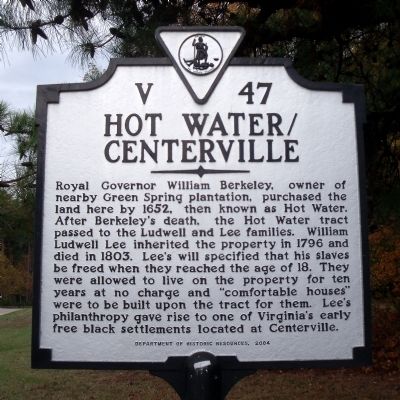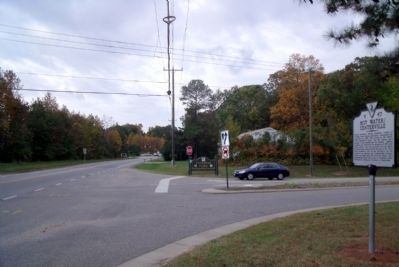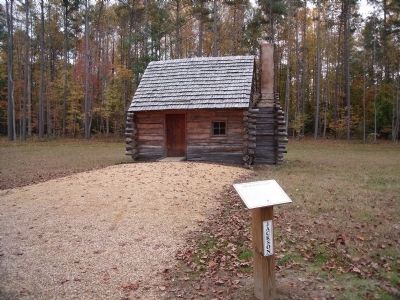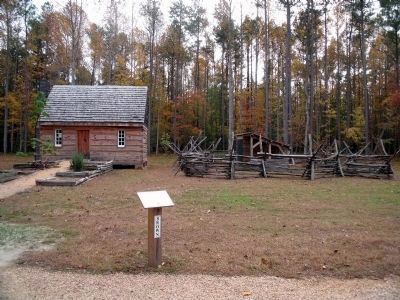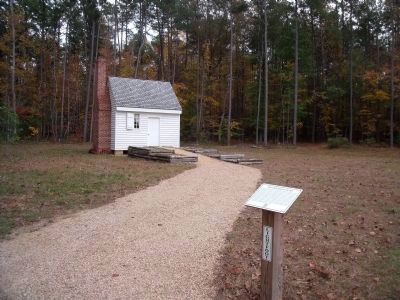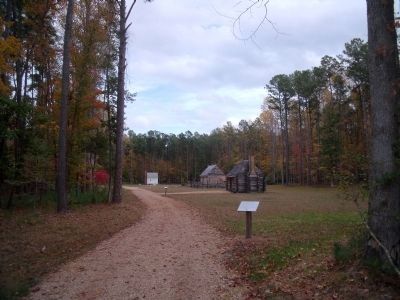Near Williamsburg in James City County, Virginia — The American South (Mid-Atlantic)
Hot Water / Centerville
Royal Governor William Berkeley, owner of nearby Green Spring Plantation, purchased the land here by 1652, then known as Hot Water. After Berkeley's death, the Hot Water tract passed to the Ludwell and Lee families. William Ludwell Lee inherited the property in 1796 and died in 1803. Lee's will specified that his slaves be freed when they reached the age of 18. They were allowed to live on the property for ten years at no charge and "comfortable houses" were to be built upon the tract for them. Lee's philanthropy gave rise to one of Virginia's early free black settlements located at Centerville.
Erected 2004 by Department of Historic Resources. (Marker Number V-47.)
Topics and series. This historical marker is listed in these topic lists: African Americans • Colonial Era • Settlements & Settlers. In addition, it is included in the Virginia Department of Historic Resources (DHR) series list. A significant historical year for this entry is 1652.
Location. 37° 18.988′ N, 76° 47.386′ W. Marker is near Williamsburg, Virginia, in James City County. Marker is at the intersection of Centerville Road (Virginia Route 614) and Longhill Road (Virginia Route 612), on the right when traveling south on Centerville Road. The marker is located at the entrance to Freedom Park. Touch for map. Marker is at or near this postal address: 5535 Centerville Road, Williamsburg VA 23188, United States of America. Touch for directions.
Other nearby markers. At least 8 other markers are within 3 miles of this marker, measured as the crow flies. Lightfoot Home (approx. half a mile away); Brown Home (approx. half a mile away); Jackson Home (approx. half a mile away); Free Black Settlement (approx. half a mile away); Early Settlement and Cemetery (approx. 0.6 miles away); Welcome to Freedom Park (approx. 0.6 miles away); Engagement at Spencer's Ordinary (approx. 0.6 miles away); Green Spring (approx. 2˝ miles away). Touch for a list and map of all markers in Williamsburg.
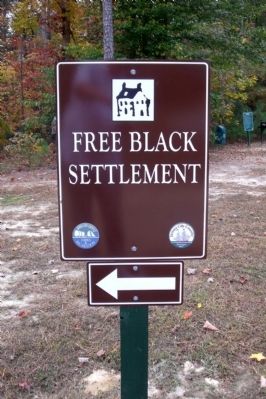
Photographed By Bernard Fisher, October 24, 2009
3. Free Black Settlement Exhibit at Freedom Park
James City County Parks & Recreation
Click for more information.
Click for more information.
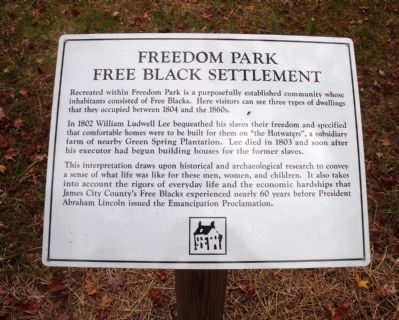
Photographed By Bernard Fisher, October 24, 2009
4. Free Black Settlement
Recreated within Freedom Park is a purposefully established community whose inhabitants consisted of Free Blacks. Here visitors can see three types of dwellings that they occupied between 1804 and the 1860s.
In 1802 William Ludwell Lee bequeathed his slaves their freedom and specified that comfortable homes were to be built for them on "the Hotwaters", a subsidiary farm of nearby Green Spring Plantation. Lee died in 1803 and soon after his executor had begun building houses for the former slaves.
This interpretation draws upon historical and archaeological research to convey a sense of what life was like for these men, women, and children. It also takes into account the rigors of everyday life and the economic hardships that James City County's Free Blacks experienced nearly 60 years before President Abraham Lincoln issued the Emancipation Proclamation.
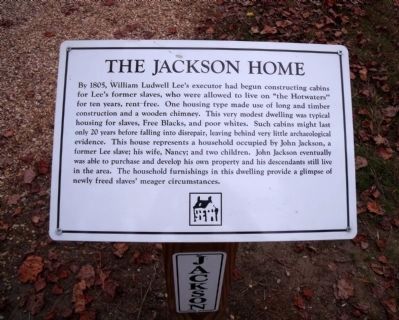
Photographed By Bernard Fisher, October 24, 2009
5. The Jackson Home
By 1805, William Ludwell Lee's executor had begun constructing cabins for Lee's former slaves, who were allowed to live on "the Hotwaters" for ten years, rent-free. One housing type made use of long and timber construction and a wooden chimney. This very modest dwelling was typical housing for slaves, Free Blacks, and poor whites. Such cabins might last only 20 years before falling into disrepair, leaving behind very little archaeological evidence. This house represents a household occupied by John Jackson, a former Lee slave; his wife, Nancy; and two children. John Jackson eventually was able to purchase and develop his own property and his descendants still live in the area. The household furnishings in this dwelling provide a glimpse of newly freed slaves' meager circumstances.
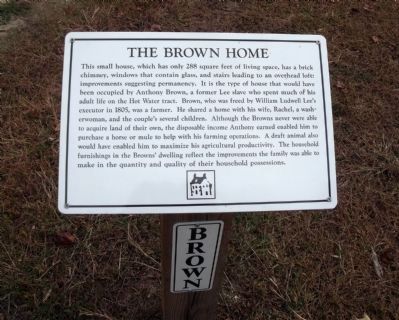
Photographed By Bernard Fisher, October 24, 2009
7. The Brown Home
This small house, which has only 288 square feet of living space, has a brick chimney, windows that contain glass, and stairs leading to an overhead loft: improvements suggesting permanency. It is the type of house that would have been occupied by Anthony Brown, a former Lee slave who spent much of his adult life on the Hot Water tract. Brown, who was freed by William Ludwell Lee's executor in 1805, was a farmer. He shared a home with his wife, Rachel, a washerwoman, and the couple's several children. Although the Browns never were able to acquire land of their own, the disposable income Anthony earned enabled him to purchase a horse or mule to help with his farming operations. A draft animal also would have enabled him to maximize his agricultural productivity. The household furnishings in the Browns' dwelling reflect the improvements the family was able to make in the quantity and quality of their household possessions.
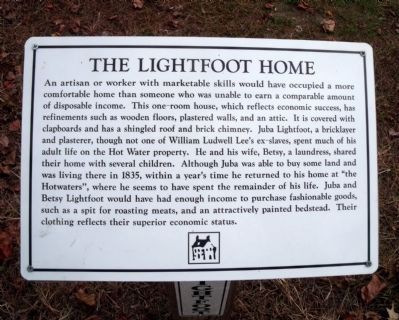
Photographed By Bernard Fisher, October 24, 2009
9. The Lightfoot Home
An artisan or worker with marketable skills would have occupied a more comfortable home than someone who was unable to earn a comparable amount of disposable income. This one-room house, which reflects economic success, has refinements such as wooden floors, plastered walls, and an attic. It is covered with clapboards and has a shingled roof and brick chimney. Juba Lightfoot, a bricklayer and plasterer, though not one of William Ludwell Lee's ex-slaves, spent much of his adult life on the Hot Water property. He and his wife, Betsy, a laundress, shared their home with several children. Although Juba was able to buy some land and was living there in 1835, within a year's time he returned to his home at "the Hotwaters", where he seems to have spent the remainder of his life. Juba and Betsy Lightfoot would have had enough income to purchase fashionable goods, such as a spit for roasting meats, and an attractively painted bedstead. Their clothing reflects their superior economic status.
Credits. This page was last revised on July 17, 2023. It was originally submitted on October 25, 2009, by Bernard Fisher of Richmond, Virginia. This page has been viewed 1,811 times since then and 127 times this year. Photos: 1, 2, 3, 4, 5, 6, 7, 8, 9, 10, 11. submitted on October 25, 2009, by Bernard Fisher of Richmond, Virginia.
